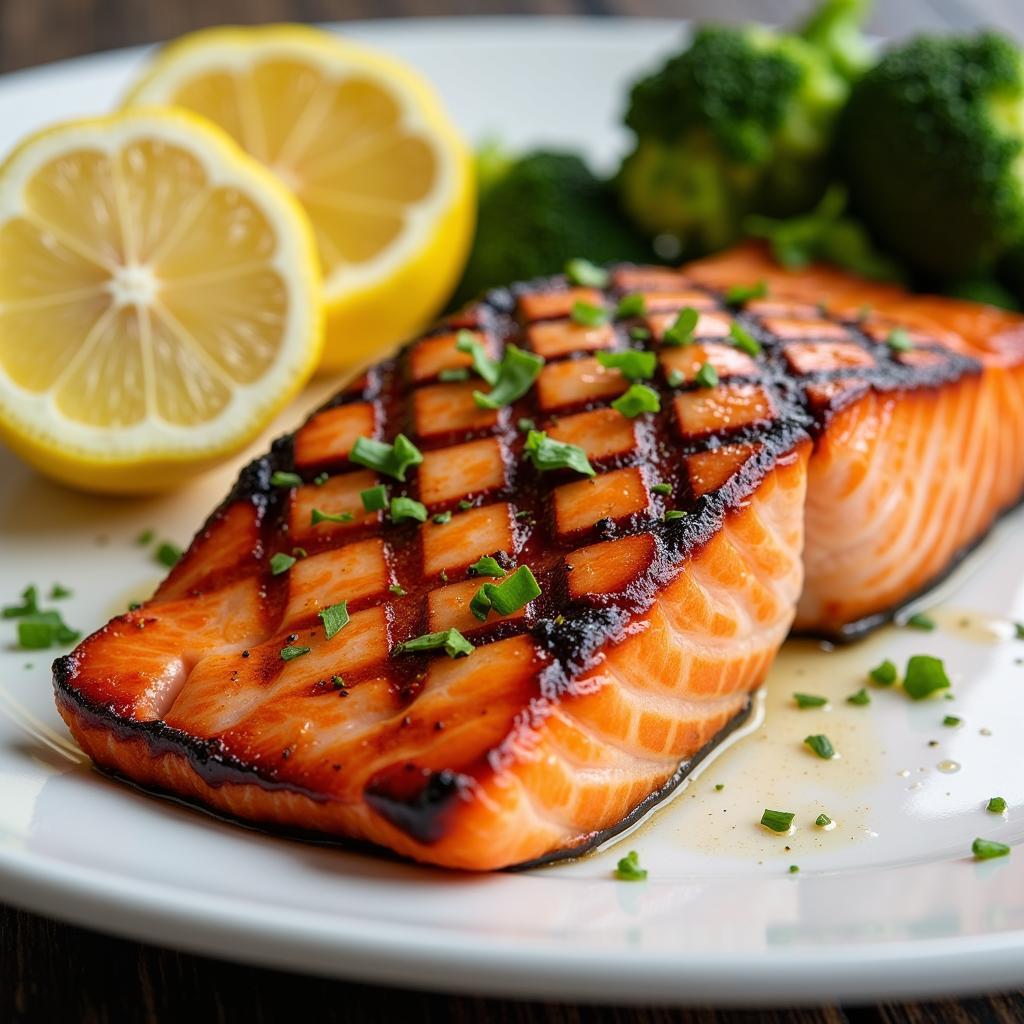For those looking to build muscle and improve their overall health, incorporating protein-rich foods into your diet is essential. And while chicken and beef often take center stage, fish offers a unique and often overlooked source of high-quality protein. Let’s dive into the world of Fish Food With High Protein and explore why it deserves a prime spot on your plate.
The Power of Protein from the Sea
Fish is considered a complete protein, meaning it provides all nine essential amino acids our bodies need but can’t produce on their own. These amino acids are the building blocks of protein, playing a vital role in muscle growth, repair, and a myriad of bodily functions. But the benefits of fish go beyond just protein.
 Fatty Fish Rich in Omega-3s
Fatty Fish Rich in Omega-3s
Exploring the Benefits
Choosing fish as your protein source comes with a unique set of advantages:
- Heart Health: Many fish, particularly fatty types like salmon, tuna, and mackerel, are abundant in omega-3 fatty acids. These healthy fats have been linked to improved heart health, lower blood pressure, and reduced risk of heart disease.
- Brain Boost: Omega-3s also play a crucial role in brain health, potentially improving cognitive function and memory.
- Vitamins and Minerals: Fish is a good source of essential vitamins and minerals like vitamin D, vitamin B12, iron, and zinc, all contributing to overall well-being.
- Versatility: From grilling and baking to pan-searing and steaming, the culinary possibilities with fish are endless, making it easy to incorporate into diverse diets.
Top Choices for High-Protein Fish
Here’s a closer look at some of the most protein-packed fish options:
- Tuna: A popular and readily available choice, tuna is incredibly versatile and boasts a whopping 30 grams of protein per 3-ounce serving.
- Salmon: Known for its rich flavor and omega-3 content, salmon provides around 25 grams of protein per 3-ounce serving.
- Cod: This mild-flavored fish is a great source of lean protein, offering about 18 grams per 3-ounce serving.
- Tilapia: A budget-friendly option, tilapia provides around 26 grams of protein per 3-ounce serving.
- Mackerel: With its distinct flavor, mackerel is a nutritional powerhouse, providing about 20 grams of protein per 3-ounce serving.
Incorporating More Fish into Your Diet
- Start Simple: If you’re new to fish, begin with mild-flavored options like cod or tilapia.
- Experiment with Recipes: Explore different cooking methods and seasonings to find your favorite ways to enjoy fish.
- Make it a Weekly Habit: Aim to include fish in your meals at least 2-3 times a week to reap its nutritional rewards.
Beyond Muscle Growth: The Holistic Benefits of Fish
While fish is undoubtedly a powerful ally in muscle building, its benefits extend far beyond gym gains. The abundance of omega-3s, vitamins, and minerals contributes to a healthier heart, sharper mind, and overall well-being.
“In my practice, I often recommend fish to patients looking to improve their health,” shares Dr. Emily Carter, a registered dietitian. “It’s a nutrient-dense food that offers a wide range of benefits, making it an excellent addition to any diet.”
Conclusion
Fish food with high protein deserves a prominent place in a balanced diet, especially for those focused on muscle growth and overall health. From its impressive protein content to its heart-healthy fats and essential nutrients, fish provides a wealth of benefits. So, the next time you’re looking for a protein boost, consider diving into the delicious and nutritious world of fish.
FAQs
1. Is canned fish as healthy as fresh fish?
Canned fish, like tuna and salmon, can be just as nutritious as fresh fish, especially when packed in water or olive oil. However, it’s essential to choose low-sodium options.
2. What are some easy ways to cook fish?
Baking, grilling, and pan-searing are all simple and healthy ways to cook fish. Seasonings like lemon, garlic, and herbs can enhance the flavor.
3. Can I eat fish every day?
While fish offers numerous benefits, it’s generally recommended to limit consumption to 2-3 servings per week.
4. How can I make sure the fish I’m buying is sustainable?
Look for certifications like the Marine Stewardship Council (MSC) label, which indicates that the fish has been caught using sustainable fishing practices.
5. Is it safe to eat raw fish?
While some types of fish are safe to consume raw, such as in sushi, it’s crucial to ensure it’s been handled and prepared correctly to minimize the risk of foodborne illness.
Explore More
Looking for delicious and healthy recipes featuring fish? Check out our articles on lysine arginine ratio food chart and homemade dog food for itchy skin. You’ll find a wealth of culinary inspiration to incorporate more fish into your diet.
For all your pet food needs, be sure to explore our range of high-quality products, including n n d dog food and farmina tropical dog food. We’re committed to providing nutritious and delicious options for your furry companions.
Have more questions about fish food with high protein or need help finding the right products for your needs? Don’t hesitate to contact us! Our team is available 24/7 to assist you. You can reach us at 02437655121, email us at minacones@gmail.com, or visit us at 3PGH+8R9, ĐT70A, thôn Trung, Bắc Từ Liêm, Hà Nội, Việt Nam.